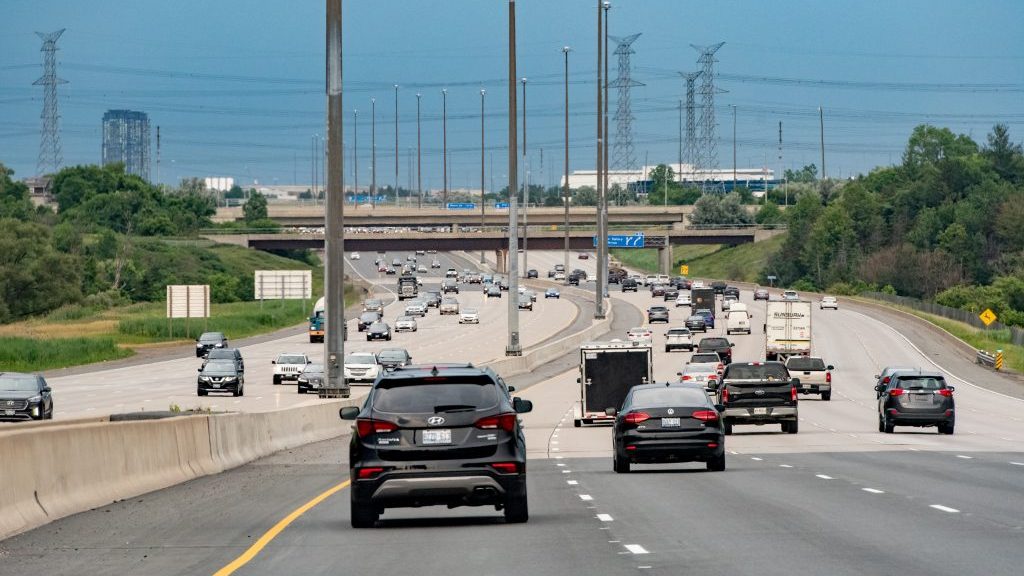A new poll finds a majority of Greater Toronto and Hamilton-Area (GTHA) residents believe a major cause of traffic and congestion is excessive construction.
The Ipsos poll, conducted for the Toronto Region Board of Trade, found 86 per cent of residents in the GTHA agree there is a traffic and congestion crisis in the region.
More specifically, sixty-eight per cent of respondents attribute the cause of traffic and congestion to excessive construction or mismanagement thereof, followed by 57 per cent who attribute it to an overabundance of cars and trucks on the road.
“We want to be really clear that the point of view of the board is we’re way behind on the infrastructure that is needed to make the city work,” said Jeff Lang-Weir, director of communications and marketing with the Toronto Region Board of Trade.
“We’re in the midst of playing catch up from a decades-long backlog on infrastructure, housing, all kinds of things that need to be constructed. Our position is that all of that is critically important…they are both things that need to be constructed.”
Eighty-five per cent of respondents believe traffic and congestion negatively impacts the GTA economy.
The poll also found three-quarters, or 76 per cent of residents, support 24-hour road and public transit construction to alleviate traffic and congestion. When asked about support in their local neighbourhoods, responses were almost identical.
‘Paying for the sins of our past’
Steven Crombie, senior director of public affairs at the Ontario Road Builders’ Association, said the findings were not a surprise.
The reality is the city is playing catch up on state-of-good-repair infrastructure and municipal asset projects such as TTC tracks, stormwater management, utility relocation, watermain replacement and road resurfacing.
“At the same time, the GTA is welcoming over 300,000 people each year and so we have to build for the future,” Crombie explained. “A lot of lane closures are associated with development which contributes to congestion. The Ontario Line transit work, the work of new home construction…we’re having to build for the future while paying for the sins of our past with respect to infrastructure neglect.”
Crombie said what’s important now is to continue to build.
With respect to 24-hour roadwork, ORBA’s position is that it’s not a one-size-fits-all solution and needs to be considered on a case-by-case basis.
“We recently canvassed our membership on recommendations on where 24/7 construction makes sense and trying to identify the challenges and opportunities with it so that we can relay that message to buyers of construction like the City of Toronto and the ministry of transportation so that they can have those considerations when going out to tender that would include 24/7 construction schedules,” Crombie said.
Need for speed
Patrick McManus, executive director of the Ontario Sewer and Watermain Construction Association, agreed it’s necessary to keep building.
“We’ve actually seen a slowdown in the amount of work being tendered this year. All that’s going to do is create worse congestion in the future because the more people that move here, the worse congestion is going to get. The longer we wait to do these projects, the worse the congestion is going to be in the future,” he explained.
“All of the road and sewer and watermain and utility construction and transit work is going to cause traffic disruption. There is no way around it,” he added. “It’s just about mitigating those issues or actually finding ways to speed projects up.”
As for 24/7 construction, McManus said it’s one of the tools in the tool box that should be used. While it can help to speed up construction timelines, it also requires more workers for night and weekend shifts.
“We do think that the city should consider phasing projects and requiring at least certain parts of those projects to go 24/7,” he said. “All that has to be done up front in the tendering process.”
Nadia Todorova, executive director of the Residential and Civil Construction Alliance of Ontario, said congestion is a result of three things: the GHTA is one of the fastest growing regions in North America; the state-of-good-repair backlog across the region has reached a breaking point; and building new transportation network capacity, including roads, highways and transit after long-delayed investment.
“Congestion across the GTHA is in a state of crisis,” said Todorova in a statement. “Everyone is impacted by it, including our industry, whose workers, materials, and equipment sit in traffic along with everyone else, impacting project timelines and increasing costs.”
The City of Toronto needs to get projects out to market more efficiently and speedily, she said.
“Red tape, ill-prepared initiatives and slow administration is resulting in costlier projects that are also slower to get shovels in the ground,” she noted. “Getting projects out to market earlier, awarding projects faster, approving contract changes in a timelier manner, and truly consulting and adopting things brought to the city by the people doing the work in the field, will all help to speed up the construction and design process.”
Follow the author on X/Twitter @DCN_Angela.






Recent Comments